PHOENIX – Grant McCagg went about his typical scouting routine during an Ottawa 67’s game at TD Place Arena in Ottawa, Ontario on March 10th.
McCagg, a retired NHL scout and now president of Recrutes.ca, arrived with pen and notebook in hand at the fan-packed arena and took his seat in a press box filled with Ontario Hockey League executives and scouts. He jotted down notes as he and others focused on a pair of players projected to go among the top-10 picks in the 2020 NHL Draft.
It seemed like business as usual in the Ontario Hockey League, until it became very unusual.
At the end of that night, hockey came to an abrupt halt.
“I remember it happened all so quickly,” McCagg said. “I didn’t go to that game thinking, ‘When’s my next game going to be?’… there was no assumption of, ‘This is going to be the last game that I scout this year.'”
But it was, and it left McCagg and other talent evaluators scrambling to adjust.
Within a week, the COVID-19 pandemic forced the five most prominent junior leagues in North America and the NCAA to freeze their regular seasons and the playoffs, depriving scouts of the opportunity to assess NHL draft-eligible prospects as they took part in some of the most competitive action of the year.
“We didn’t get to see them in the high-pressure, tight-checking playoff games (and) how these prospects would react and play,” McCagg said. “This year I think is going to be one where you see more mistakes made (in evaluating players) than usual, in hindsight, because of the lack of total preparation in viewing.”
The art of scouting has shifted dramatically since the global health crisis materialized.
However, the Arizona Coyotes new general manager, Bill Armstrong, is not afraid to tackle the challenge.
Armstrong is credited with assembling a St. Louis Blues club that won the Stanley Cup in 2019. But the seeds of his success were planted when he started as an amateur scout in 2004.

Tim Bernhardt (left), the former Arizona Coyotes director of scouting, said watching video has always been an important part of the scouting process but added it has become even more valuable during the coronavirus pandemic. (Photo by Bruce Bennett/Getty Images)
“I’ve driven those roads at 2 in the morning where there are logging trucks coming at you,” Armstrong said during his introductory press conference in September. “I love people that are on the ground, who are going to bleed for you.”
Armstrong shrugged off the challenges of rebuilding the Coyotes with the added obstacle of a global pandemic.
“It’s challenging for every NHL organization,” Armstrong said. “I think the good news is that, whenever something happens, you have to find a way around it. You have to adapt. My dad used to always talk about it: ‘Adapt or die, son. Adapt or die.’ That’s what this situation is about.”
Rather than gathering at rinks to watch players up close as they have in the past, scouts now must spend hours in front of computer screens absorbing what they can from video that’s available online and conducting interviews via technology like Zoom.
“At this time last year, I had no idea what a Zoom call was,” said Jeff Twohey, the former assistant director of amateur scouting for the Coyotes. “Now, it’s commonplace. You need to understand technology like Zoom now more than ever. Because of COVID-19, guys are forced to watch way more video, because seasons were cut short.”
“Video is becoming a part of scouting more and more,” said Tim Bernhardt, who was the Coyotes’ director of amateur scouting from 2014 to 2018. ” It’s always been a supplementary way to view players, and I think teams will look at that even more.”
Using Zoom has been a positive for the NHL’s 31 teams as they’ve adjusted to the situation. And while Armstrong pointed out that video scouting has reduced staffing and travel costs, there is a human cost to consider.
“COVID-19 has hit the scouting business really hard,” Twohey said. “You look at teams now. They don’t have any revenue coming in. They’re laying off people. The ability to hire people is becoming more difficult. It certainly has some short-term ramifications and probably some long-term ones as well.”
In the short run, scouts are required to travel less since there is simply very little competition to scout anyway. The Quebec Major Junior Hockey League is the only league that has initiated a 2020-21 campaign, and it has already been suspended due to COVID-19 hotspots in the league’s regions.
“There are restrictions, but it didn’t matter because there was nowhere to go,” Bernhardt said.
And there are other complications to consider, even if play resumes at some point. For instance, border crossings between countries, and even Canadian provinces, can require an isolation period, similar to procedures of the NHL’s Return To Play.
“As an Ontario resident, for me to go to the maritime provinces now, I have to quarantine for 14 days,” Twohey said. “Before, crossing borders and going to Europe was relatively easy. Now, it puts anyone who travels at some kind of risk when you’re flying and going into busy areas.”
But the process has also revealed some advantages to the new world of scouting.
Traditionally, scouts would conduct 15-minute group interviews with draft-eligible prospects at the NHL Scouting Combine in early June. This year’s combine, planned to be held in Buffalo, New York, was postponed due to the uncertainty of COVID-19. Instead, scouts were forced to conduct individual interviews through a camera’s eye.
It turned out to be a good thing in some ways, and a disadvantage in others, according to Twohey.
“When we used to do it at the combine, I think it was intimidating to the players,” Twohey said. “They would come into a small room and there were maybe 10 people always grilling them. When you’re doing it through Zoom, I think players are more relaxed.
“It’s a little tougher to get a read on their body language.”
Depending on the status of the pandemic next spring, in-person assessment and physical conditioning tests could again be absent from the evaluation process leading up to the 2021 NHL Draft.
Can teams learn enough through Zoom, video, and analytics to assess a player’s makeup and potential?
“I think next year will be the big test,” Bernhardt said. “Next year’s draft is going to be tricky where we’re headed.”


